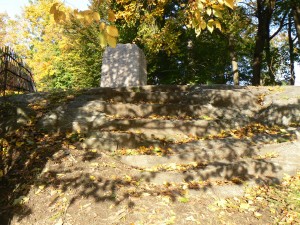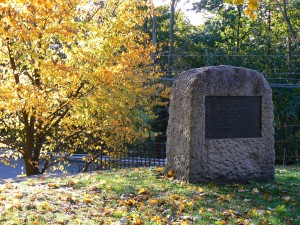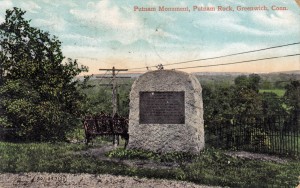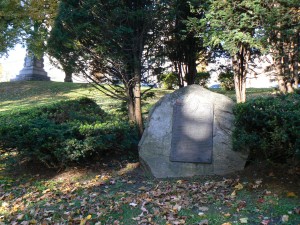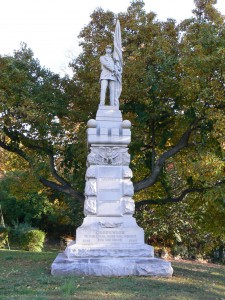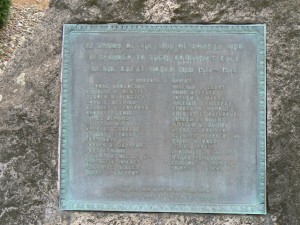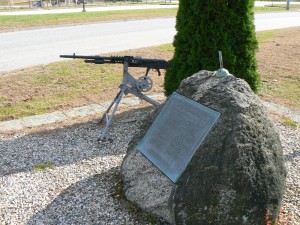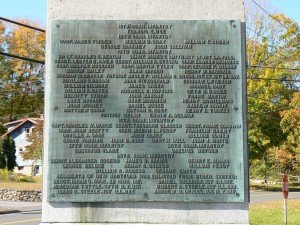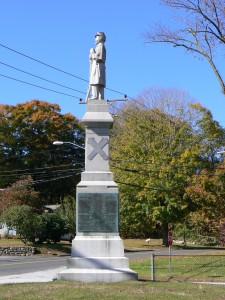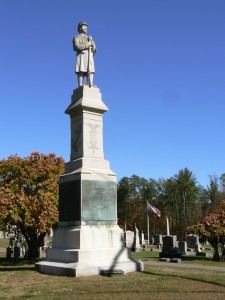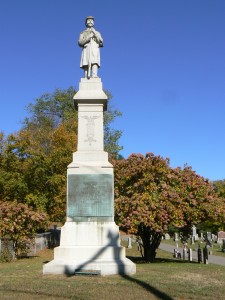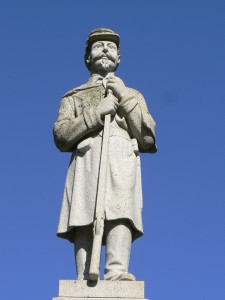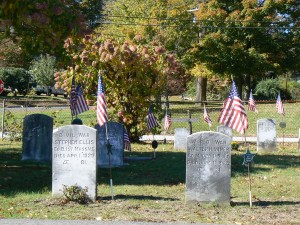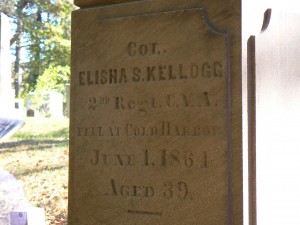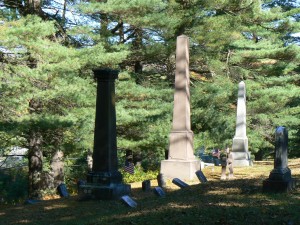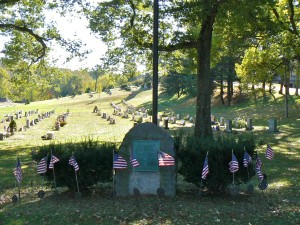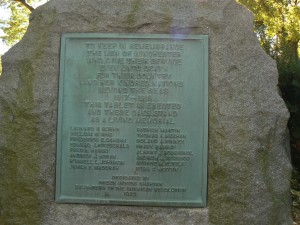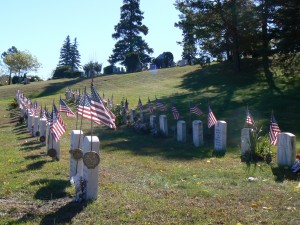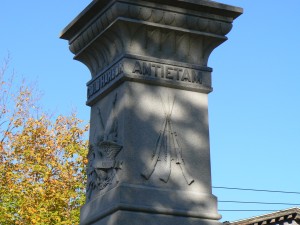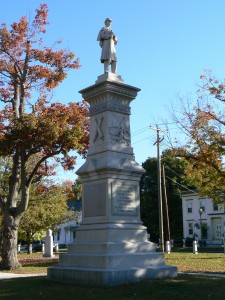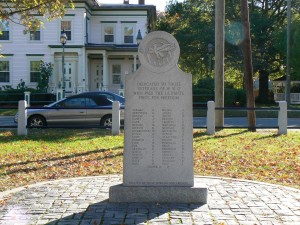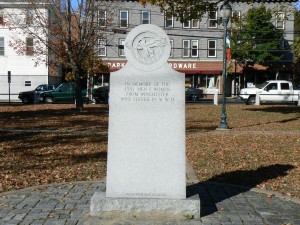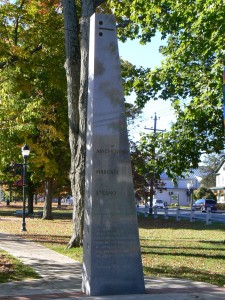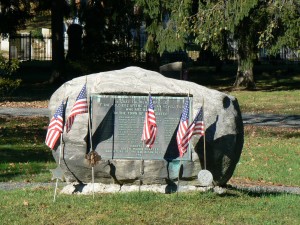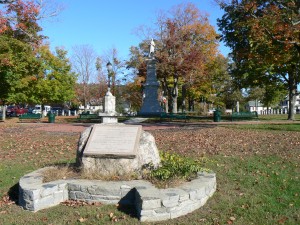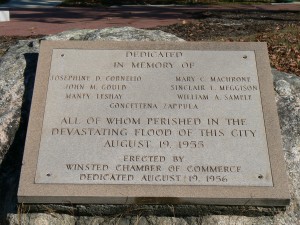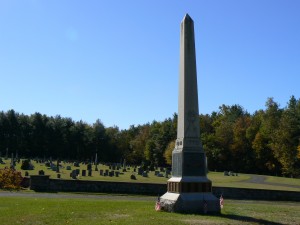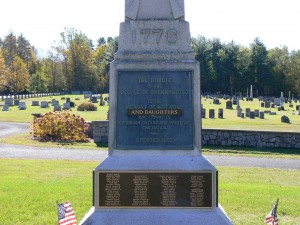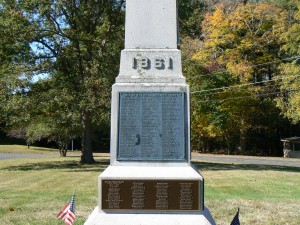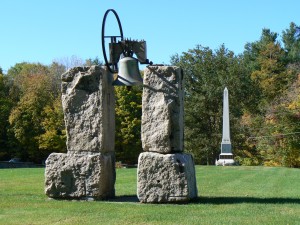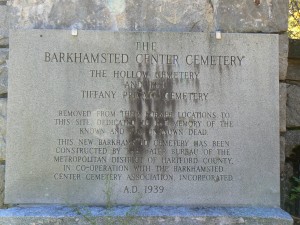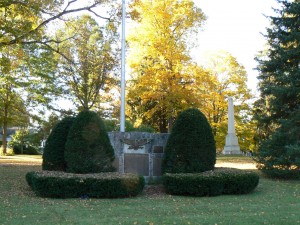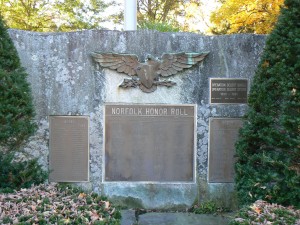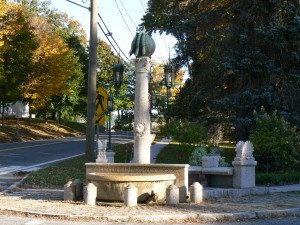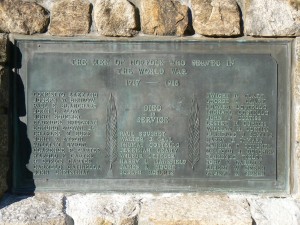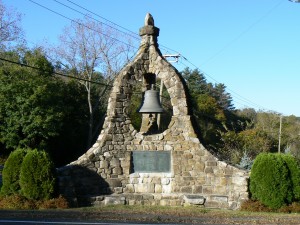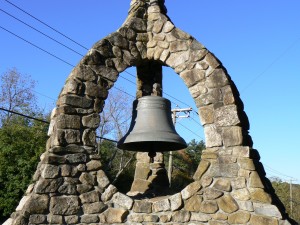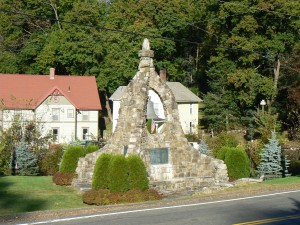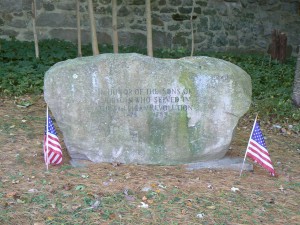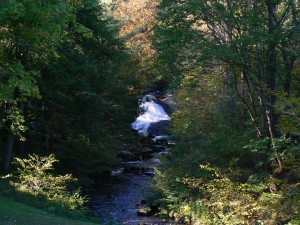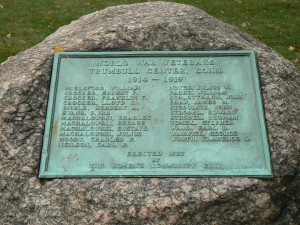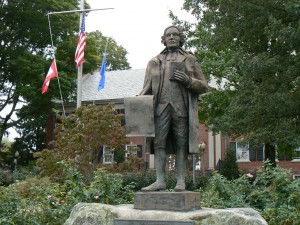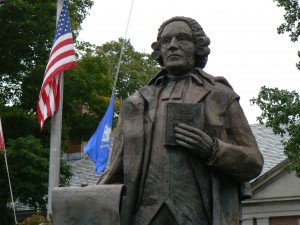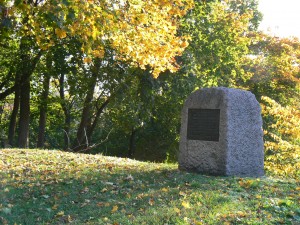 Greenwich honors the escape of Gen. Israel Putnam from British forces during the American Revolution with a monument on East Putnam Avenue (Route 1).
Greenwich honors the escape of Gen. Israel Putnam from British forces during the American Revolution with a monument on East Putnam Avenue (Route 1).
The monument stands at the top of a steep hill, near the corner of East Putnam Avenue and Old Church Road, down which Putnam reportedly rode as British forces invaded Greenwich.
The monument bears a plaque on its west face reading, “This marks the spot where on February 26, 1779, Gen. Israel Putnam, cut off from his soldiers cut off from his soldiers and pursued by British Cavalry, galloped down this rocky steep and escaped, daring to lead where not one of many hundred foes dared to follow.”
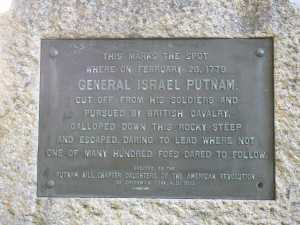 Accounts differ about the details of Putnam’s escape, and legends describing the event have been embellished enough over the years that figuring out what really happened is somewhat difficult.
Accounts differ about the details of Putnam’s escape, and legends describing the event have been embellished enough over the years that figuring out what really happened is somewhat difficult.
Most accounts agree Putnam rode down the hill as part of a retreat of outnumbered Continental forces stationed in Greenwich. Putnam is believed to have been at nearby Knapp’s Tavern as British troops arrived.
Putnam was heading to Stamford to gather reinforcements and warn residents when he rode his horse down a steep hillside into which crude steps had been carved.
Most accounts have British cavalry deciding not to chase Putnam down the hillside, and some say a ball fired from a British pistol struck Putnam’s hat.
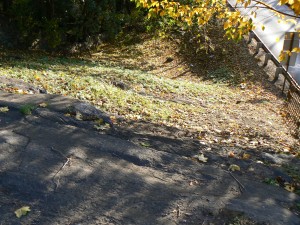 Standing at the top of the hillside, it looks like a pretty dangerous place to ride, especially on a cold February day. No doubt the horse wasn’t thrilled about the idea, either.
Standing at the top of the hillside, it looks like a pretty dangerous place to ride, especially on a cold February day. No doubt the horse wasn’t thrilled about the idea, either.
The vintage postcard near the bottom of this post depicts a since-removed bench overlooking the hillside. The fence visible in the postcard appears to be the same one at the site today.
The event is commemorated in other locations as well. Knapp’s Tavern was converted in 1906 into the Putnam Cottage museum.
A statue by Anna Hyatt Huntington in Putnam Memorial State Park depicts Putnam’s downhill escape from the British.
Tags: Greenwich
 Greenwich honors its founders with a monument on East Putnam Avenue (Route 1).
Greenwich honors its founders with a monument on East Putnam Avenue (Route 1).
The monument, near the intersection of East Putnam Avenue and Maple Avenue, was dedicated in 1935 by the Daughters of the American Colonists to honor the town’s first English settlers.
The monument features a bronze plaque attached to the southern face of a boulder. The plaque bears a dedication reading, “In memory of the courageous men who founded the first settlement of the Town of Greenwich in the Connecticut Colony, July 18, 1640.”
The monument also includes two lists of names reflecting the assembly of Greenwich from two land purchases from Native Americans.
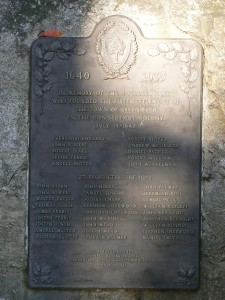 The first purchase, in 1640, included today’s Old Greenwich section. The second, in 1672, included the Field Point section.
The first purchase, in 1640, included today’s Old Greenwich section. The second, in 1672, included the Field Point section.
The upper section of the monument lists 10 residents who made the 1640 purchase.
The lower section of the monument lists 27 residents responsible for the Field Point purchase.
The founders’ monument stands at the base of a hill, below the 1890 Soldiers’ and Sailors’ Monument.
Tags: Greenwich
 Bozrah honors its World War I veterans with a monument dedicated in 1938.
Bozrah honors its World War I veterans with a monument dedicated in 1938.
The monument, at the intersection of Fitchville Road and Bozrah Street Extension, features a boulder flanked by two machine guns.
The boulder has a dedication plaque reading, “In honor of the men of Bozrah who responded to their country’s call in the great World War 1917-1919.”
The monument lists 33 residents who served in the World War, and honors one resident killed in the war.
The base of the plaque has the Biblical passage from John 15:13, “Greater love hath no man than this, that a man lay down his life for his friends.”
Tags: Bozrah
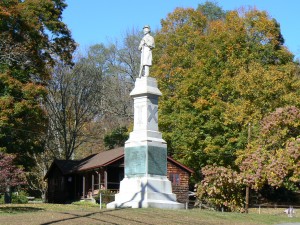 New Hartford honors its Civil War veterans with a 24-foot-tall monument in the southwest corner of Village Cemetery.
New Hartford honors its Civil War veterans with a 24-foot-tall monument in the southwest corner of Village Cemetery.
The Soldiers’ and Sailors’ Monument stands near the cemetery entrance along Town Hill Road (Route 219).
A dedication on the monument’s front (south) base reads, “Erected 1892 to the memory of New Hartford soldiers and sailors who served in the War of the Rebellion, 1861 1865.”
The south face also displays a medallion representing the Grand Army of the Republic, the post-Civil War veterans’ organization.
The east face bears a bronze plaque listing about 60 New Hartford residents or natives who served in the conflict. Veterans are listed according to their regimental affiliation, with officers listed first.
 The north and west faces also have plaques honoring the service of New Hartford’s Civil War veterans.
The north and west faces also have plaques honoring the service of New Hartford’s Civil War veterans.
The figure atop the monument stands, facing south, with a rifle supported by his hands. The extension of the rifle’s butt beyond the monument’s base is an uncommon artistic touch.
The monument was supplied by the Temple Brothers of Rutland, Vermont. The New Hartford monument is the only Civil War memorial in Connecticut supplied by the firm.
A number of veterans of the Civil War and later conflicts are buried in the section to the immediate north of the monument.
Tags: New Hartford
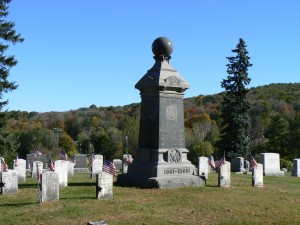 Winchester honors veterans of the Civil War, World War I and other conflicts with several monuments in Forest View Cemetery.
Winchester honors veterans of the Civil War, World War I and other conflicts with several monuments in Forest View Cemetery.
The Non-Repatriated Soldiers’ Monument, in the Winsted section of Winchester, was dedicated in 1900 to honor local Civil War heroes buried on distant battlefields.
The dark granite monument, topped with a polished sphere, stands at the center of a section of the cemetery with 21 graves of Civil War veterans who died after war.
A dedication on the front (south) face of the monument reads, “Erected by the State of Connecticut and citizens of the town in memory of Winchester volunteers who died or were killed in the War of the Rebellion and whose bodies were not brought home for burial.”
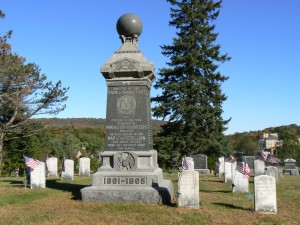 The south face also bears the years of the Civil War, the U.S. seal and crossed flags, and the Latin inscription “Pro Patria (for one’s country).
The south face also bears the years of the Civil War, the U.S. seal and crossed flags, and the Latin inscription “Pro Patria (for one’s country).
The monument’s east face lists the names and regimental affiliations of 21 residents lost in the conflict. The north face honors 10 residents whose service was credited to other towns, and the west face lists 22 residents.
According to the Connecticut Historical Society, information about the monument’s designer or supplier isn’t readily available.
The corners of the Civil War burial section have supports that once held round objects, such as cannonballs or granite spheres. Cannonballs incorporated into Civil War monuments have been removed in several other Connecticut locations, often due to theft, vandalism or World War II scrap metal drives.
Civil War Heroes
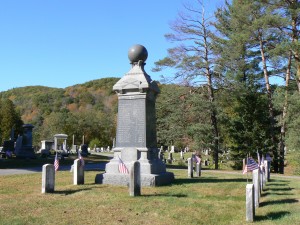 To the immediate north of the Civil War section is the burial place for Samuel Belton Horne, an Irish immigrant and Winsted resident who received a Congressional Medal of Honor for actions in 1864. Horne’s horse was shot out from under him while he was delivering a message during a battle at Fort Harrison, Virginia.
To the immediate north of the Civil War section is the burial place for Samuel Belton Horne, an Irish immigrant and Winsted resident who received a Congressional Medal of Honor for actions in 1864. Horne’s horse was shot out from under him while he was delivering a message during a battle at Fort Harrison, Virginia.
At the western edge of Forest View Cemetery is a brownstone obelisk marking the grave of Col. Elisha S. Kellogg, a member of the 2nd Regiment of the Connecticut Volunteer Artillery who was killed in 1864 during the Battle of Cold Harbor, Va.
Two crosses next to the obelisk mark the graves of Kellogg and his wife, Polly.
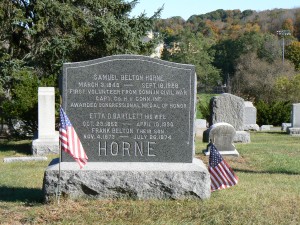 The Kellogg obelisk was repaired and cleaned in August by rangers from the Antietam battlefield as well as members of the Connecticut Civil War Roundtable and the 2nd Connecticut Heavy Artillery re-enactment group.
The Kellogg obelisk was repaired and cleaned in August by rangers from the Antietam battlefield as well as members of the Connecticut Civil War Roundtable and the 2nd Connecticut Heavy Artillery re-enactment group.
A number of graves near the Kellogg obelisk also list service in the Civil War.
Honoring Other Veterans
Near Forest View’s entrance on Torrington Road, a 1923 monument and a grove of trees honor Winchester’s World War I veterans.
The monument features a bronze plaque mounted on a boulder surrounded by trees. The plaque has a dedication reading, “To keep in remembrance the men of Winchester who gave their service, even unto death, for their country and her kindred nations beyond the seas, 1917 – 1918, this tablet is erected and these oaks stand as a living memorial.”
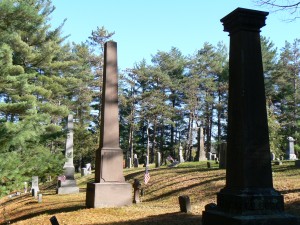 The plaque honors 16 residents lost in the First World War.
The plaque honors 16 residents lost in the First World War.
At the base of a hillside near the north end of the cemetery, two rows of graves honor veterans of more recent wars.
Tags: Winchester, Winsted
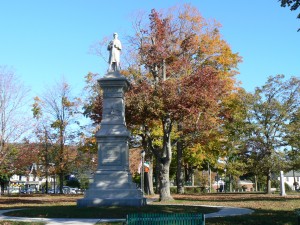 The 1904 Soldiers’ Monument in the Winsted section of Winchester stands at the south end of East End Park, near the green’s intersection with Main Street (Route 44)
The 1904 Soldiers’ Monument in the Winsted section of Winchester stands at the south end of East End Park, near the green’s intersection with Main Street (Route 44)
The 27-foot monument features an infantryman standing atop a large granite shaft. A dedication on the monument’s front (south) face reads, “For the dead, a tribute. For the living, a memory. For posterity, an emblem of loyalty to the flag of their country.”
The south face also features a decorative trophy with an eagle and two crossed flags, and honors the Battle of Cold Harbor.
 The east face bears three crossed rifles, symbolizing the infantry, and honors the Battle of Antietam.
The east face bears three crossed rifles, symbolizing the infantry, and honors the Battle of Antietam.
The north face has another dedication reading, “In honor of the patriotism and to perpetuate the memory of the 368 brave men who went forth from this town from 1861 to 1865 and periled their all that the nation might live, this monument has been erected so that all who come after them may be mindful of their deeds and fail not in the day of trial to emulate their example.”
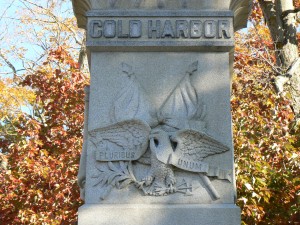 The north face also features the state seal and honors the Battle of Port Hudson, La.
The north face also features the state seal and honors the Battle of Port Hudson, La.
The west face displays crossed cannons, symbolizing the artillery, and honors the Battle of Petersburg, Va.
The monument was donated by Winsted native Charles Pine, who served in the Civil War and later became president of the Ansonia National Bank. Pine also donated a memorial chapel in Ansonia’s Pine Grove Cemetery.
The monument was erected in 1904 and dedicated in May of 1905.
Moving slightly north on the green, a 2000 memorial to the 1,551 Winchester residents who served in World War II lists 39 names of residents killed in the conflict.
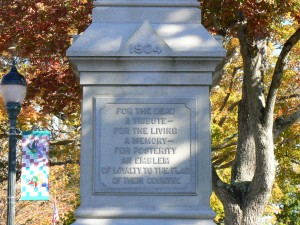 At the far north end of the green, a granite pillar honors three residents killed in Vietnam.
At the far north end of the green, a granite pillar honors three residents killed in Vietnam.
To the west of the green, near the entrance to the Winsted Old Burying Ground cemetery, a 1907 monument honors the 44 American Revolution veterans buried within Winchester’s borders.
At the far south end of the green, a 1956 monument honors seven residents killed in the Naugatuck River Valley flood in the summer of 1955.
Winchester’s Civil War veterans are also honored with the elaborate Winchester Soldiers’ Monument on Crown Street as well as a memorial in Forest View Cemetery.
Tags: Winchester, Winsted
 Veterans of the Civil War and later conflicts are honored with monuments on the green in Norfolk.
Veterans of the Civil War and later conflicts are honored with monuments on the green in Norfolk.
The 1868 Soldiers’ Monument, one of the earliest tributes to Civil War veterans in Connecticut, is a tall granite obelisk similar to monuments in Plymouth, North Branford and other monuments dedicated in the late 1860s.
The Norfolk monument bears a dedication on its western face reading, “To the memory of the soldiers from this town who died for their country in the war of the rebellion.”
The western face also lists the names and dates of death of seven residents killed in the Civil War.
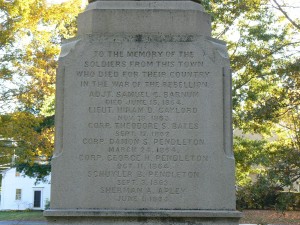 The southern, eastern and northern faces of the monument list each list nine or 10 names and dates of death, in rough alphabetical order.
The southern, eastern and northern faces of the monument list each list nine or 10 names and dates of death, in rough alphabetical order.
The Norfolk monument was supplied by William Burdick, an agent of the Westerly, R.I. quarries who also supplied the monument in North Branford.
At the northern end of the green, an undated Honor Roll monument commemorates local veterans who died or served in more recent conflicts.
The monument’s central plaque lists four residents killed in World War II as well as four columns of names honoring those who served. Looking at the names, it’s pretty common to see between three and six members of various families listed on the plaque.
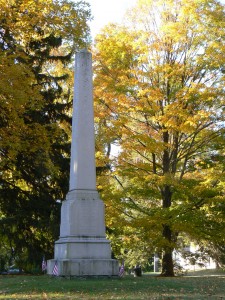 To the left as you face the monument, a plaque lists 51 residents who served in the Korean War (including at least five residents who had previously served in World War II).
To the left as you face the monument, a plaque lists 51 residents who served in the Korean War (including at least five residents who had previously served in World War II).
The Vietnam plaque on the right side of the Honor Roll lists 77 names, including two who were killed in the war. Another plaque on the monument’s right side honors three residents who served in Operation Desert Storm.
At the south end of the green, a memorial fountain dedicated in 1889 honors Joseph Battell, a local merchant whose family was long active in civil and philanthropic affairs.
The fountain, designed by noted architect Stanford White, features a central column supporting a sphere. Water emerges from three fish near the top of the column as well as a lion’s head on its southern face.
The fountain, with spigots that provide water for horses and for people, is rather unusual in that it’s still serving as a fountain. Most commemorative fountains from that era have long been converted into planters.
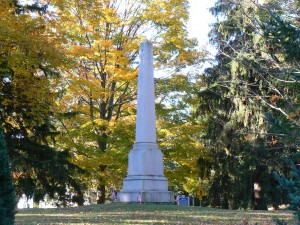 Battell’s heirs donated the family home to Yale to serve as the summer home of the university’s music school.
Battell’s heirs donated the family home to Yale to serve as the summer home of the university’s music school.
The town’s World War I veterans are honored with a monument at the intersection of Greenwoods Road (Route 44) and North Street (Route 272).
Tags: Norfolk
 Norfolk honors its World War I veterans and heroes with a triangular monument featuring a replica of the Liberty Bell.
Norfolk honors its World War I veterans and heroes with a triangular monument featuring a replica of the Liberty Bell.
The monument, dedicated on Armistice Day in 1921, stands on Memorial Green at the intersection of North Street (Route 272) and Greenwoods Road (Route 44).
The monument features three archways rising from a triangular base with long benches. A replica of the Liberty Bell hangs in the niche below the intersection of the archways. The monument is topped with a stone design that appears to resemble an eternal flame.
The south face of the monument’s base has a dedication plaque with the years of the World War and an inscription reading, “In honor of those who gave and those who offered their lives for liberty, the people of Norfolk have built this monument and crowned it with the Liberty Bell in the faith that it will ring the knell of war and proclaim the brotherhood of man.”
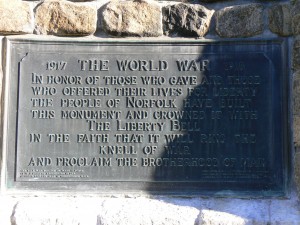 The northeast face features a plaque honoring the eight residents lost in the World War as well as the names of 30 local veterans.
The northeast face features a plaque honoring the eight residents lost in the World War as well as the names of 30 local veterans.
A plaque on the monument’s northwest face lists 41 names of residents who served in the conflict.
The monument was designed by Alfredo S.G. Taylor, who was also responsible for more than 30 buildings in Norfolk.
Memorial Green also features a number of trees planted in honor of the World War heroes.
Across Greenwoods Road, a monument dedicated in 1976 as part of the U.S. bicentennial celebration honors Norfolk’s American Revolution veterans. The monument stands in a small park that offers views of Buttermilk Falls.
Source: Smithsonian American Art Museum, Art Inventories Catalog
Tags: Norfolk
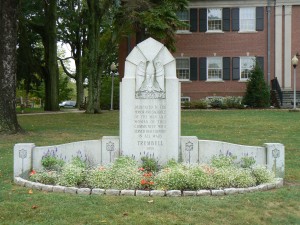 Trumbull honors its war veterans as well as the colonial governor for which it is named with monuments in front of Town Hall.
Trumbull honors its war veterans as well as the colonial governor for which it is named with monuments in front of Town Hall.
A granite monument on the eastern side of the green in front of Town Hall honors Trumbull’s veterans. A dedication on the front (northwest) face reads, “Dedicated to the honor and sacrifice of the men and women of this community who served our country in all wars, Trumbull, 1958.”
The southeast face lists Trumbull residents lost in wars dating back to the French and Indian War (one name) and continuing through Vietnam (five names). The American Revolution and World War I sections both list one name. The Civil War section lists 16 names, and the World War II section honors 22 residents. (Trumbull’s World War II heroes are also honored with a monument in Beach Memorial Park).
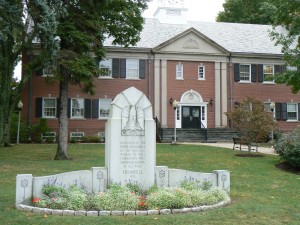 Not far from the war memorial, a boulder monument honors the service of 23 veterans from the Trumbull Center section of town in the First World War (including four from one family, three from another and two from a third family).
Not far from the war memorial, a boulder monument honors the service of 23 veterans from the Trumbull Center section of town in the First World War (including four from one family, three from another and two from a third family).
On the western side of the green, a 2002 statue honors Jonathan Trumbull, for whom the town was named in 1797. Trumbull, a Lebanon native, served as governor from 1769 to 1784. Trumbull had the unique distinction of being appointed by the British and later being elected by residents of the newly independent state.
The statue, by sculptor John Janvrin Blair, depicts Trumbull holding a Bible in one hand and the Declaration of Independence in the other.
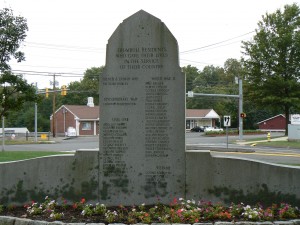 Trumbull, along with Roger Sherman, is one of two Connecticut notables honored in the U.S. Capitol’s Statuary Hall collection.
Trumbull, along with Roger Sherman, is one of two Connecticut notables honored in the U.S. Capitol’s Statuary Hall collection.
Tags: Trumbull
